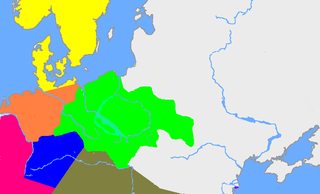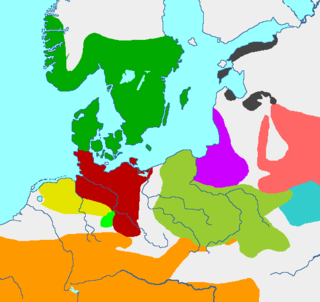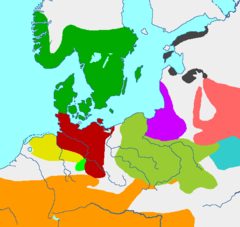
The La Tène culture was a European Iron Age culture. It developed and flourished during the late Iron Age, succeeding the early Iron Age Hallstatt culture without any definite cultural break, under considerable Mediterranean influence from the Greeks in pre-Roman Gaul, the Etruscans, and the Golasecca culture, but whose artistic style nevertheless did not depend on those Mediterranean influences.

The Iapydes were an ancient people who dwelt north of and inland from the Liburnians, off the Adriatic coast and eastwards of the Istrian peninsula. They occupied the interior of the country between the Colapis (Kupa) and Oeneus (Una) rivers, and the Velebit mountain range which separated them from the coastal Liburnians. Their territory covered the central inlands of modern Croatia and Una River Valley in today's Bosnia and Herzegovina. Archaeological documentation confirms their presence in these countries at least from 9th century BC, and they persisted in their area longer than a millennium. The ancient written documentation on inland Iapydes is scarcer than on the adjacent coastal peoples that had more frequent maritime contacts with ancient Greeks and Romans.

The Urnfield culture was a late Bronze Age culture of Central Europe, often divided into several local cultures within a broader Urnfield tradition. The name comes from the custom of cremating the dead and placing their ashes in urns, which were then buried in fields. The first usage of the name occurred in publications over grave sites in southern Germany in the late 19th century. Over much of Europe, the Urnfield culture followed the Tumulus culture and was succeeded by the Hallstatt culture. Some linguists and archaeologists have associated this culture with a pre-Celtic language or Proto-Celtic language family. By the end of the 2nd millennium BC, the Urnfield Tradition had spread through Italy, northwestern Europe, and as far west as the Pyrenees. It is at this time that fortified hilltop settlements and sheet‐bronze metalworking also spread widely across Europe, leading some authorities to equate these changes with the expansion of the Celts. These links are no longer accepted. The Italic peoples, including the Latins, from which the Romans emerged, come from the Urnfield culture of central Europe.

The Lusatian culture existed in the later Bronze Age and early Iron Age in most of what is now Poland and parts of the Czech Republic, Slovakia, eastern Germany and western Ukraine. It covers the Periods Montelius III to V of the Northern European chronological scheme. It has been associated or closely linked with the Nordic Bronze Age. Hallstatt influences can also be seen particularly in ornaments and weapons.

The Pomeranian culture, also Pomeranian or Pomerelian Face Urn culture was an Iron Age culture with origins in parts of the area south of the Baltic Sea, from the 7th century BC to the 3rd century BC, which eventually covered most of today's Poland.

Old Prussians, Baltic Prussians or simply Prussians were a tribe among the Baltic peoples that inhabited the region of Prussia, at the south-eastern shore of the Baltic Sea between the Vistula Lagoon to the west and the Curonian Lagoon to the east. The Old Prussians, who spoke an Indo-European language now known as Old Prussian and worshipped pre-Christian deities, lent their name, despite very few commonalities, to the later, predominantly Low German-speaking inhabitants of the region.

The Przeworsk culture was an Iron Age material culture in the region of what is now Poland, that dates from the 3rd century BC to the 5th century AD. It takes its name from the town Przeworsk, near the village where the first artifacts were identified.

The Oksywie culture was an archaeological culture that existed in the area of modern-day Eastern Pomerania around the lower Vistula river from the 2nd century BC to the early 1st century AD. It is named after the village of Oksywie, now part of the city of Gdynia in northern Poland, where the first archaeological finds typical of this culture were discovered.
The archaeology of Northern Europe studies the prehistory of Scandinavia and the adjacent North European Plain, roughly corresponding to the territories of modern Sweden, Norway, Denmark, northern Germany, Poland and the Netherlands.

Ameno is a comune (municipality) in the Province of Novara in the Italian region of Piedmont, located about 100 kilometres (62 mi) northeast of Turin and about 40 kilometres (25 mi) northwest of Novara. As of 31 December 2004, it has a population of 906 and an area of 10.0 square kilometres (3.9 sq mi).
In Europe, the Iron Age is the last stage of the prehistoric period and the first of the protohistoric periods, which initially meant descriptions of a particular area by Greek and Roman writers. For much of Europe, the period came to an abrupt end after conquest by the Romans, though ironworking remained the dominant technology until recent times. Elsewhere, the period lasted until the early centuries AD, and either Christianization or a new conquest in the Migration Period. Iron working was introduced to Europe in the late 11th century BC, probably from the Caucasus, and slowly spread northwards and westwards over the succeeding 500 years. For example, the Iron Age of Prehistoric Ireland begins around 500 BC, when the Greek Iron Age had already ended, and finishes around 400 AD. The use of iron and iron-working technology became widespread concurrently in Europe and Asia.

The Bronze and Iron Age cultures in Poland are known mainly from archeological research. Early Bronze Age cultures in Poland began around 2400–2300 BCE, while the Iron Age commenced in approximately 750–700 BCE. The Iron Age archeological cultures no longer existed by the start of the Common Era. The subject of the ethnicity and linguistic affiliation of the groups living in Central Europe at that time is, given the absence of written records, speculative, and accordingly there is considerable disagreement. In Poland the Lusatian culture, spanning both the Bronze and Iron Ages, became particularly prominent. The most famous archeological finding from that period is the Biskupin fortified settlement (gord) on the lake from which it takes its name, representing the Lusatian culture of the early Iron Age.

Poland in antiquity was characterized by peoples from various archeological cultures living in and migrating through various parts of what is now Poland, from about 400 BC to 450–500 AD. These people are identified as Slavs, Celts, Germanic peoples, Balts, Thracians, Avars, and Scythians. Other groups, difficult to identify, were most likely also present, as the ethnic composition of archeological cultures is often poorly recognized. While lacking any written language to speak of, many of them developed a relatively advanced material culture and social organization, as evidenced by the archeological record; for example, richly furnished, "princely" dynastic graves.

The prehistory of Italy began in the Paleolithic period, when species of Homo colonized the Italian territory for the first time, and ended in the Iron Age, when the first written records appeared in Italy.

After the glaciers of the Ice Age in the Early Stone Age withdrew from the area, which since about 1000 AD is called Pomerania, in what are now northern Germany and Poland, they left a tundra. First humans appeared, hunting reindeer in the summer. A climate change in 8000 BC allowed hunters and foragers of the Ertebølle-Ellerbek culture to continuously inhabit the area. These people became influenced by farmers of the Linear Pottery culture who settled in southern Pomerania. The hunters of the Ertebølle-Ellerbek culture became farmers of the Funnelbeaker culture in 3000 BC. The Havelland culture dominated in the Uckermark from 2500 to 2000 BC. In 2400 BC, the Corded Ware culture reached Pomerania and introduced the domestic horse. Both Linear Pottery and Corded Ware culture have been associated with Indo-Europeans. Except for Western Pomerania, the Funnelbeaker culture was replaced by the Globular Amphora culture a thousand years later.

The Bura culture refers to a set of archeological sites in the lower Niger River valley of Niger and Burkina Faso. More specifically, the Iron Age civilization exemplified by the Bura culture was centered in the southwest portion of modern-day Niger and in the southeast part of contemporary Burkina Faso.
Part of series of articles upon Archaeology of Kosovo

The Jorwe culture was a Chalcolithic archaeological culture which existed in large areas of what is now Maharashtra state in Western India, and also reached north into the Malwa region of Madhya Pradesh. It is named after the type site of Jorwe. The early phase of the culture is dated to c. 1400-1000 BCE, while the late phase is dated to c. 1000-700 BCE.
Central Bosnian culture was a cultural group that emerged during the Bronze and Iron Ages. This group inhabited the upper and mid course areas of the Vrbas river and the Bosna river, and constituted an independent cultural and ethnic community. Hillfort-type settlements were typical of this group and were often located close to major areas of cultivable land. The standard of housing in these settlements was high. Around 120 hill forts belonging to this culture have been identified in the area of Central Bosnia. This group is commonly associated with the later Illyrian tribe of Daesitiates.
Saridkel is an ancient site located in the khunti district of Jharkhand. There are ancient ruins of burnt brick houses found on the site along with redware pottery, copper tools, coins, gold earrings and iron tools. Well fortified buildings suggest that it was probably a royal house or Monastery belonging to the 1st or 2nd century CE, according to the archeological department.















